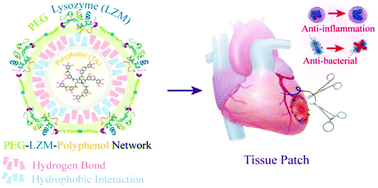Coupling PEG-LZM polymer networks with polyphenols yields suturable biohydrogels for tissue patching†
Abstract
Poor mechanical performances severely limit the application of hydrogels in vivo; for example, it is difficult to perform a very common suturing operation on hydrogels during surgery. There is a growing demand to improve the mechanical properties of hydrogels for broadening their clinical applications. Natural polyphenols can match the potential toughening sites in our previously reported PEG-lysozyme (LZM) hydrogel because polyphenols have unique structural units including a hydroxyl group and an aromatic ring that can interact with PEG via hydrogen bonding and form hydrophobic interactions with LZM. By utilizing polyphenols as noncovalent crosslinkers, the resultant PEG-LZM-polyphenol hydrogel presents super toughness and high elasticity in comparison to pristine PEG-LZM with no obvious changes in the initial shape, and it can even withstand the high pressure from sutures. At the same time, the mechanical properties could be widely adjusted by varying the polyphenol concentration. Interestingly, the PEG-LZM-polyphenol hydrogel has a higher water content than other polyphenol-toughened hydrogels, which may better meet the clinical needs for hydrogel materials. Besides, the introduction of polyphenols endows the hydrogel with improved antibacterial and anti-inflammatory abilities. Finally, the PEG-LZM-polyphenol (tannic acid) hydrogel was demonstrated to successfully patch a rabbit myocardial defect by suturing for 4 weeks and improve the wound healing and heart function recovery compared to autologous muscle patches.



 Please wait while we load your content...
Please wait while we load your content...